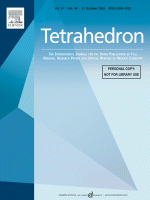







|
|
|
Journal
Publications |
|
Diastereospecific carbonylation of
p-allylpalladium
complexes to give 3,6-disubstituted 3,6-dihydro-1H-pyridin-2-ones.
Julian G. Knight, and Kirill Tchabanenko,
Tetrahedron, 2002,
58, 6659. |
|
Abstract: (Ph3P)2PdCl2
was found to be the most effective of a range of catalysts for
decarboxylative carbonylation of (4S,5RS)-5-ethenyl-4-(2-propyl)oxazolidin-2-one
to give the δ-lactam, (6S)-3,6-dihydro-6-(2-propyl)-1H-pyridin-2-one.
In a similar way, diastereoisomerically pure (4S,5S)-4-benzyl-5-((Z)alk-1-enyl)oxazolidin-2-ones
undergo stereospecific carbonylation to give (3R,6S)-6-benzyl-3-alkyl-3,6-dihydro-1H-pyridin-2-ones.
The diastereoisomeric (4S,5R)-4-benzyl-5-((Z)alk-1-enyl)oxazolidin-2-ones
give rise to a separable mixture of the corresponding (3S,6S)-6-benzyl-3-alkyl-3,6-dihydro-1H-pyridin-2-one
and (4S,5S)-4-benzyl-5-((E)alk-1-enyl)oxazolidin-2-one.
Under more forcing conditions, the latter oxazolidinone is carbonylated
to the 3,6-anti-pyridinone. The stereochemical course of the
reactions can be rationalized by formation of a π-allyl palladium cation
with inversion of configuration followed by carbonylation with
retention. The stereospecificity observed in our system precludes
metal–metal exchange of the π-allyl complexes by a Pd(0) displacement
process. |
| |
|
|
|



